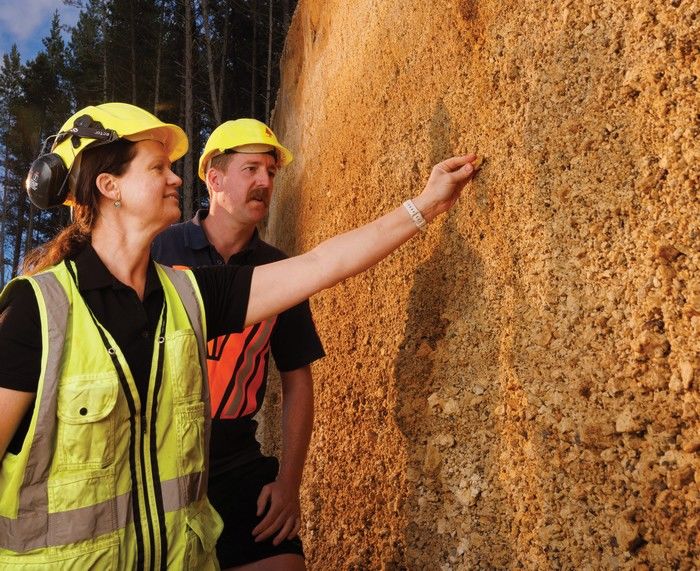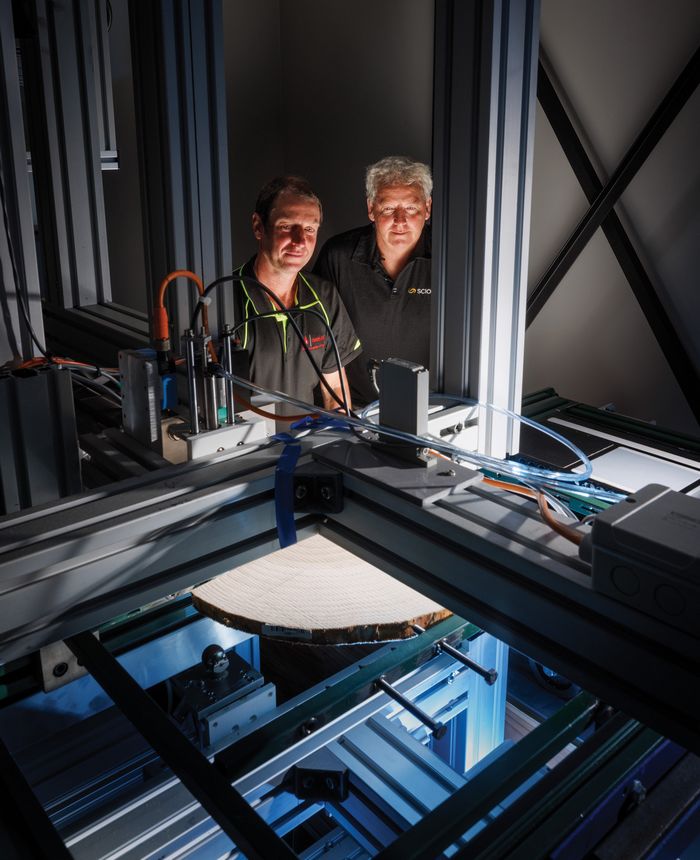Timberlands’ big, hairy, audacious goal

In May 2017, the Timberlands Ltd Board of Directors and senior managers toured through Puruki Experimental Forest in the Central North Island with a team of Scion scientists. As they stood on the top of a hill in Puruki they could see their own Kaingaroa Forest estate, just 20 kilometres to the east and they knew that they needed to think big. Really big.
Scion’s Puruki Experimental Forest is one of the most productive radiata pine plantations in New Zealand. What the Timberlands directors saw with their own eyes at Puruki were pine growth rates twice what they were achieving in Kaingaroa Forest. This showed the Timberlands Board what was possible and helped drive the goal to double productivity in Kaingaroa Forest over the next 30 years.
That means catapulting average growth rates from 25 cubic metres per hectare per year to 50 cubic metres annually, by 2050. Fifty cubic metres by 2050 became known as ‘50 by 50’. By Timberlands’ own admission – this is a big, hairy, audacious goal.
For Dr John Moore, research and development manager at Timberlands, 50 by 50 is the focus of several research themes.
“We’re conscious that our research – and indeed everything we do at Timberlands – can have environmental and social outcomes on a large scale,” says Moore. “With big, hairy, audacious goals comes big, serious responsibility.”
Scion principal researcher, Dr Peter Clinton, says the Resilient Forests research programme is delivering the underpinning knowledge that will help companies such as Timberlands achieve their goals around productivity and sustainability.
At 205,000 hectares, Kaingaroa Forest is the largest planted forest in New Zealand. It covers just over 0.7 percent of New Zealand’s land area. Ninety percent of that land is in productive forest, with radiata pine comprising 95 percent of trees. The company is involved in harvesting and marketing over four million tonnes of logs each year.
A century before Timberlands came up with its big, hairy, audacious goal, the New Zealand Government had equally ambitious plans of its own. It would create a forestry industry.
A history of experimentation
Up until the 1890s, forestry in New Zealand was based on logging of indigenous forests. It was becoming obvious that this type of forestry was unsustainable. The government took the first, tentative steps to finding exotic tree alternatives, and embarked on the ambitious plan of creating a plantation forest resource in the Central North Island. The first plantings in Kaingaroa Forest were seedlings that were raised in a nursery on land that would later become the Scion campus.
Plantings boomed in the 1920s and the Kaingaroa Forest became one of the crown jewels of international forestry. It is one of the oldest and largest softwood plantations in the world. From the original plantings of the 1920s, the forest (both the land and the trees) were owned as a state asset by the New Zealand Government.
On 1 July 2009, ownership of the land under Kaingaroa Forest was transferred to iwi that were the traditional landowners. The trees themselves were to be owned by a private company (Kaingaroa Timberlands), which holds a forestry licence over the land. The New Zealand Superannuation Fund owns 42 percent of Kaingaroa Timberlands, so a significant proportion of the company’s profits are returned back to all New Zealanders.
The history of research in Kaingaroa Forest began in 1901 when the Lands Department planted a modest two-hectare experimental plot of Douglas-fir near Kaingaroa village. A shelterbelt of radiata pine surrounded the Douglas-fir trees. At the time, radiata pine was not considered a serious contender as a forestry species. By 1932, the height of the Douglas-fir trees were 24 metres tall, while the radiata pine averaged 39 metres and had more than twice the diameter of the Douglas-fir trees.
Radiata pine exceeded all expectations. Partially in response to managing this fast-growing forest estate, research began in 1947 with the establishment of the Forest Experiment Station (FES) where Scion’s Rotorua campus is today. Two years later, FES became the Forest Research Institute (FRI), rebranding as Scion in 2005.
At FRI, great strides were made towards understanding every step of the plantation forestry lifecycle – from selecting the best trees to form the basis of tree breeding programmes, development of silvicultural regimes through to multiple end uses of timber and wood fibres. The need to manage, protect and use wood from Kaingaroa Forest influenced several strands of FRI’s research programmes.
In 1949, drought and wildfire in the forest combined with dense overstocked stands of trees created a ‘perfect storm’ for attack by the Sirex wasp. By the mid-1950s, a third of trees in the Kaingaroa Forest were affected by this pest. This led to new research into plant health, entomology, soil science and stand management. Over the decades, FRI’s research reputation grew so much that by the end of the 20th century the Institute had become a world leader in plantation forestry science. Those accomplishments were not achieved in isolation. Many of Scion’s near neighbours played a large part in guiding and progressing science through the decades.
The science behind 50 by 50
Scion itself is located at Te Papa Tipu Innovation Park on 115 hectares of Ngā Hapu e Torū whenua (land) where it is surrounded by 24 organisations and businesses devoted to the forestry industry.
It’s one of the few such research institutes to enjoy such close contact with end users. Endless problems related to forestry have been discussed (and solved) over a cup of tea between Scion staff and those working in the industry.
“You have those robust debates over a cuppa,” says Moore. “One of those debates addressed the role of fertiliser in the forest. For years we have only seriously considered applying fertiliser to commercial pine plantations to overcome specific nutrient deficiencies,” he says.
“The soils under Puruki are essentially the same as Kaingaroa but have a greater nutrient capital. If fertiliser was applied to the forest to improve growth rather than to address a deficit, the potential exists to increase pine growth rates in Kaingaroa.”
To test this, in 2018 Timberlands worked with Scion to establish large, replicated fertiliser trials where different rates of fertiliser blends were applied.
The initial results are looking promising. On average, three years after fertiliser was applied there was at least a 30 percent increase in radiata pine tree growth rate in the fertilised plots compared to controls. At the more extreme end, some plots showed a 50 percent increase in growth.
There is a risk that applying fertiliser could come at a cost – wood quality. The implication is that 50 by 50 could be achieved but the benefits would be less if the marketability of this resource is reduced.
To make sure that does not happen, Timberlands is using Scion’s DiscBot to benchmark the wood that trees produce within the Kaingaroa Forest estate. The insights gained will help them to understand the impacts of different forest management practices on future resource quality.
“We are particularly interested in corewood properties, many of which aren’t that easy to characterise using other methods,” says Moore.
Scion’s DiscBot is a wood scanning platform that scans a much greater proportion of a tree than other technologies. It is designed to assess a range of wood properties that affect the quality of sawn timber and other end products. The scanner uses different sensors to capture information on wood density, microfibril angle, chemical composition and spiral grain angle.
Moore says that the DiscBot data has already shown that some clones are correlation breakers. These are clonal lines of trees that are both superior for growth and for wood properties. DiscBot data is just starting to roll in from the 2018 fertiliser trials.
“Waiting until the trees are felled at harvest is simply too long,” says Moore. “If there is going to be an adverse impact of added fertiliser on wood – we’re best to know straight away before we get a ‘big, hairy surprise’ in the marketplace 20 years from now.”

Future-proofing forests for 2050
For Timberlands, climate change is already happening. Timberlands technical manager Ian Hinton brings up a diagram on his laptop showing rainfall across the Kaingaroa Forest over the last 60 years. Blue shows more rainfall than normal, orange and green show an average amount and red means drier than average. Six of the past eight years are ‘fire engine red’. That raises alarm bells. Only two or three years in the previous 52 years in the Kaingaroa Forest were as dry as we are routinely experiencing now.
“What we’ve started seeing in the forest over the past decade are harvest volumes being less than predicted, anecdotally more dead trees observed by felling crews and growth models that appear to over-predict forest growth and volumes,” says Hinton.
“Pragmatically, we don’t know a lot about the future – other than the fact that a lot can happen in a 30-year pine rotation. The practices of the past, and some of the research that went into those practices may not cut it in the future. We cannot help but innovate for the future. The investment in the past Kaingaroa estate is far too important for that, as are the efforts of past generations.”
The Resilient Forests Research programme was set up to address future risks and help forest managers prepare says Clinton. The programme was co-developed with Forest Growers Research, the Forest Owners Association and the NZ Farm Forestry Association and funded by the Forest Growers Levy Trust. It builds on the progress made by the Growing Confidence in Forestry’s Future and the Healthy Trees Healthy Future research programmes.
Kaingaroa Forest was established at a time when New Zealand needed it. The Forest Experiment Station, Forestry Research Institute and now Scion today have been there in support with science that has helped grow Kaingaroa Forest and other planted forests around New Zealand.
